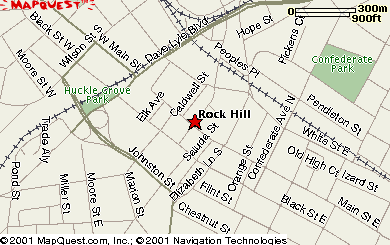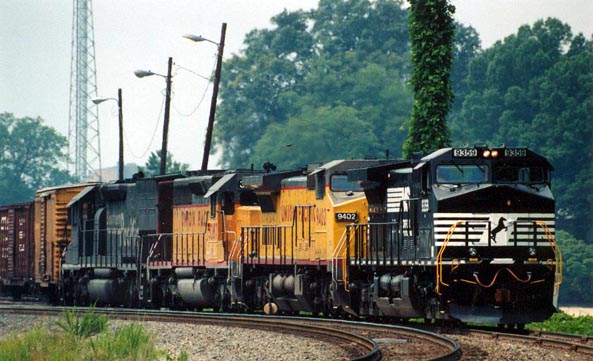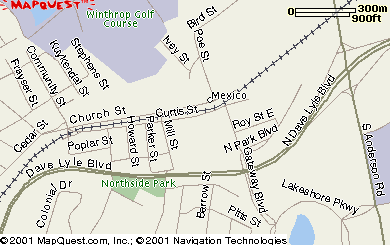

Overcoming Train Traffic
by Joseph C. Hinson
November 10, 2001
On this past Sunday, the Herald out of Rock Hill ran a front page story with the headline, "Overcoming Train Traffic." A picture of a stopped train across White Street also was published. Mind you, this was a front page story during a time when our soldiers are still dropping bombs on Afghanistan. Overcoming train traffic? Are there not other things we should overcome first? Little things like terrorism, prejudice, cancer... reality based TV?
I will copy the entire article here and then comment on it at the end.
Overcoming train traffic
By Jason Cato The Herald
(Published November 5, 2001)
Stopped trains and blocked traffic are not lucrative incentives when it comes to spurring an urban renaissance.
That's why Rock Hill leaders are looking for ways to eliminate the congestion of major downtown intersections - namely Main and White streets at Dave Lyle Boulevard - from idle trains that not only impede traffic but also economic development.
Plans, ranging from short-term fixes to a long-term solution, would go a long way in helping the city realize its Old Town Renaissance plan for urban revitalization.
An immediate change of fewer trains coming through Rock Hill will reduce the amount of time traffic is blocked downtown, but the city's golden plan - building a new rail crossing at Quantz Street - would eliminate the problem all together.
Not only would it move stopped trains about a half mile farther from downtown, it would also open an overlooked section of town to new development, city officials say.
"Dave Lyle Boulevard has become a dividing line of where people want to go and develop and where they don't," said Stephen Turner, director of the Rock Hill Economic Development Corp.
While there are no concrete plans to build the Quantz Street crossing, Turner said it is a necessary piece of the puzzle for a more vibrant downtown district. He said the real focus of redevelopment in the next 10 to 15 years will be the area between downtown and Winthrop University.
"The fact that those roads are blocked by traffic two to three hours every day make the prospects of redevelopment more difficult," he said.
Tim Morgan, director of the York County Regional Chamber of Commerce, agreed.
"The setup we have now tends to create a division in the downtown area," he said. "Anything that can help move the physical barrier of the trains would be a real help."
Morgan wouldn't go as far as to say that the trains hurt downtown business, but he said they certainly don't help.
"There's some vacant land on the other side of the tracks that can be developed with the rest of downtown if they were better connected," Morgan said.
Though there has been heavy development on the east side of Dave Lyle Boulevard over the years, development on the west side - along Black, Main and White streets - has been minimal, Turner said.
Reversing this trend will be one of the major focuses of the downtown revitalization plan, Turner said, citing plans to renovate former mills such as the Rock Hill Cotton Factory and the Rock Hill Printing & Finishing Co., also known as the Bleachery.
"The redevelopment of that area is probably the biggest economic development and community development challenge that Rock Hill faces in the next 10 to 15 years," Turner said. "The railroad crossings become an important part of that strategy."
Turner included the project in the next phase of the master plan for 2003 to 2005, but he said that does not necessarily mean that is when it will take place.
"This is a long-term strategy," he said. "It's just an opportunity that has been put on the table."
The idea for the Quantz Street crossing originally was presented to city officials two years ago by representatives of Norfolk Southern Railroad. Turner said they proposed building the new crossing and closing the two at Aragon and Mill streets because of odd intersections and a steep hill at one of the crossings that makes seeing the other side impossible.
Roy Strickland, the train master for Rock Hill, said the plan was shot down after objections from the neighborhoods surrounding those crossings.
Still, Strickland said, it's a plan the railroad would welcome.
"I would love to see that new crossing," he said, "and so would a lot of our people."
Turner said the city's desire for urban redevelopment adds a different element to the plan and gives it new life.
"Suddenly, trying to do something with these crossings has another reason other than safety," he said.
City and railroad officials produced two other plans after meeting earlier this year to determine what other measures could be taken to alleviate the downtown traffic congestion caused by stopped trains.
The first was to reduce the number of daily trains traveling through Rock Hill from Columbia to Charlotte that block downtown traffic. Norfolk Southern started running two trains rather than three in mid September.
They also discussed a plan to stop adding train cars in Rock Hill - a process that typically takes 30 to 45 minutes - and move that operation to Charlotte instead.
That idea was scrapped because the railroad company said it was economically unfeasible.
Turner said he plans to meet again with Norfolk Southern, state transportation officials and community leaders again within the next year.
Strickland said he understands the city's desire.
"I'm sure there are a lot of towns around with this same issue that are trying to redevelop their downtowns," he said. "We want to work with the city any way we can, as long as it would be productive for both them and us.
"Railroads are changing everyday. ... One day it may happen."
First of all, I have to be nice to the Herald. Later today, one of their reporters, Erica Pippins, is going to interview me for a possible story they're doing? The subject of the story? My interest in railroads, specifically the L&C. So hopefully they won't read this before that story goes to print. Also, a side note to the editor of the Herald, let's talk hypothetically here. If, by chance, I come to you seeking a job after I get out of school, one as a photographer, please don't take this rant personally. I mean, I did basically scoop your paper with the L&C story I had in the Lancaster News. It's not our fault the the Lancaster paper only comes out three times a week. It's also not our fault that your reporter made two glaring mistakes in his/her story about the L&C, both of which I corrected you on in an e-mail that you never replied to.
But, anyway...
Moving on from there, this article in the Herald shows a gigantic anti-Norfolk Southern bias not only by the paper, but by the individual reporter as well as Stephen Turner, Rock Hill Economic Development Corporation Director and Tim Morgan, director of the York County Regional Chamber of Commerce. Turner more than Morgan should know better. He would, it seems, have to work with the railroad on other matters and this probably is not going a long way to creating a good atmosphere between the two parties.
Now another point I must address: As a railfan, a photographer whose main point of interest so far is railroads and a local historian -- I added that last part for the people that may have found this site from the Herald article that they may not even run if they see this rant first -- I must say that I do not have a bias against the city leaders of Rock Hill. I do think they are short sighted on this front, not thinking everything through and blaming Norfolk Southern for a mess that they -- the city leaders -- created in the first place! That's pretty childish, if you think about it.
Quick! What came first? The railroad through Rock Hill or this road? Answer: the railroad by one hundred years or so.
But a lot of the problem really isn't a problem at all if you don't let it become one. Northbound horses do block two roads on the south end of the yard. In fact, Southern, the railroad at the time Dave Lyle was created, as I understand it, lost some land in the process of this road construction. I mean, if you're going to build a busy road right beside the railroad tracks, have the decency not to moan and groan about it twenty years later.
First, let's acquaint ourselves with the map, provided that the map is actually attached. The track that comes in from the south west and heads out of the map in the middle, so to speak, going north east is what's left of the ex-Southern SB line. It crosses Dave Lyle via a bridge.

The track under the bridge and running along Dave Lyle is the Columbia to Charlotte main. In railroad terms, this is a north-south line.
Going back to where the SB crosses the R line, the first road that crosses the track is White Street. The next is Main Street. Both of these are grade crossings and can be blocked for thirty minutes or more while they are switching out cars. The only alternative would be to cut the train in two places. But then you run the risk of clogging another street about a mile away that would be more troublesome than these crossings. That's also why you could not stop the train on the south side of Main Street. (The road in question is not on the map, but as I said, having this road blocked is entirely more burdensome than White and Main.)
One block over from White Street is Black Street. This road goes under the tracks as does the next road over, Johnston Street. The city leaders have complained about NS clogging White and Main for years and years. probably since Dave Lyle was built RIGHT BESIDE THE TRACKS.
But all you have to do is to go one block over if you're on Main Street to get on Black Street. If you're on White Street, you can either go two blocks over (I got good math skills.) to Black and go a block over the other way and get on Oakland. Oakland crosses the tracks via a bridge.
So all of this bitching and moaning and groaning is for naught if you simply GO ONE OR TWO BLOCKS OVER. In other ways, if you think the train is in your way, MOVE!!! In fact, north of this map, if you're on Main Street coming into town, they have made it easy for you to get onto Black Street at a light that is almost always green. It's technically a right hand turn, but it's more like a right hand veer. That means if you're coming into town on Main from the north, you can easily get away from a train that probably isn't going to be in the first place!
Norfolk Southern as of October only tuns four main line trains on this track. That number does not include several locals that may from time to time block these crossings. One of these locals handles traffic for the Lancaster and Chester. A few of them also handle Bowater business. The only way to get rid of the latter would be to run Bowater out of town.
That's why I feel Stephen Turner and Tim Morgan are being very short sighted in this matter. Without the railroads, a lot of the industry they are using to attract this development would not be in Rock Hill in the first place! Mr. Turner, Mr. Morgan, the railroad is not your enemy in this case, as I have demonstrated.
But I'm not finished. Let's discuss the other side of the railyard.
From the article, this:
"An immediate change of fewer trains coming through Rock Hill will reduce the amount of time traffic is blocked downtown, but the city's golden plan - building a new rail crossing at Quantz Street - would eliminate the problem all together.
"Not only would it move stopped trains about a half mile farther from downtown, it would also open an overlooked section of town to new development, city officials say."
I have read this part a few times and I still can't make sense of it. Refer to the next attachment down below, also from Mapquest.
We are now north of where we were in the last post. Northbound trains that switch out of the Rock Hill Yard will not clog any road with the exception of the crossing near the left hand side of the map. I know, I know. Some dissertation, to coin a phrase from Andy, but this map is not easy to read. You have roads coming together here and it's hard to keep up with the names.

The busiest road is Cedar Street, it comes into Community, crosses the tracks and then turns into Curtis if you believe this map. Heck, I could hop in my car and go the two miles to see for myself, but I'm already doing too much for little payback.
Anyway, this will be the only crossing they block as they are switching cars on this end of the track. (Keep in mind, White and Main will be blocked as they do this.) So if you're on Cedar and there's a train blocking Community, what do you do? What do you do? Well, you go down Church Street, hit Mill Street and slide onto Curtis that way. We're not talking about miles out of your way here.
Again from the article:
"The idea for the Quantz Street crossing originally was presented to city officials two years ago by representatives of Norfolk Southern Railroad. Turner said they proposed building the new crossing and closing the two at Aragon and Mill streets because of odd intersections and a steep hill at one of the crossings that makes seeing the other side impossible.
"Roy Strickland, the train master for Rock Hill, said the plan was shot down after objections from the neighborhoods surrounding those crossings."
Ah, yes, the NIMBYs. The Not In My Backyards all across the country have done wonderful things from happening just so they won't be inconvenience. For example, a plant was looking to move to Richburg a few years ago along I-77 at the Highway 9 exit. But the nearby NIMBYs complained about things that COULD happen if this company moved there. Chester County leaders, state leaders, officials from the company and the railroad that would serve it, the Lancaster and Chester, tried to convince the neighbors that they problems they thought MIGHT exist in the future could be fixed here and now. The NIMBYs were not impressed and that major tract of land that could conceivably employ thousands of people in Chester and Lancaster still sits undeveloped. Just so the people that live near the area would not be inconvenienced, which they never probed would happen in the first place.
Aragon must be the intersection that is hard to get a name on. It is clearly marked with red lights and dinging bells, though no arms. Mill Street is a heck of a climb and should be closed. Therefore, building the crossing at Quantz makes a certain amount of sense.
Except for the fact that a crossing here is not going to "eliminate the problem all together," as the Herald said. This new crossing, in fact, will not affect the trains blocking White and Main at all. And as I said in the last post, this really isn't much of a problem at all.
Now, southbound trains.... They do block Mill Street as the crew is switching out the yard but not Aragon/Community. If Quantz was a crossing at grade (the paper doesn't mention if the proposal is for the road to cross the tracks at grade, below or above) it too would be blocked. If the trains stopped before Quanzt, I'm thinking there are other roads on the other side of Anderson (which goes under the tracks) which would then be crossed and would cause that area to be more problematic to navigate.
Now as I have said, the railroad came through Rock Hill about one hundred years before Dave Lyle Boulevard. It's possible that the houses were there before Dave Lyle. Hypothetically, let's say that these houses were built in the 1920s, 30s and 40s. I'm using my good math skills here... give me a minute... Nope, still doesn't beat the railroad.
A word of advice to people that do not like trains: Don't move to a neighborhood that has a railroad running through it! It's like complaining against the noise at an airport when you've lived there ten years, but the airport has been there for fifty. The airport wins! In this case, the railroad should have priority. It's much more important to the economy of the area than some busy NIMBY who has entirely too much time on their hands.
So another word of advice to these people: if you don't like the trains blocking the roads that much, GET OUT!!!
I hope I've explained myself well. Maybe I should send out some letters detailing this (written better, of course) to Stephen Turner, the Herald, a few council members and the like. Then again, they probably wouldn't understand the logic.
to
my next rant (when posted)
My
Rants and Raves
The
Joseph C. Hinson Home Page